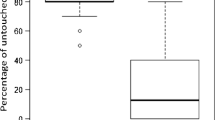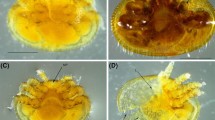Abstract
LikeApis cerana colonies,A. mellifera colonies also show removal response toVarroa-infested brood cells. Infested worker brood cells of artificially and naturally infested combs were detected by the worker bees to various degrees in all types of comb-material used.
The bees uncap brood cells and remove larvae or pupae infested with one or two mites. The removal response of worker bees was stronger towards brood cells containing two mites than cells with one mite.
The specific signals which cause the removal of brood cells infested withVarroa mites are unknown. Removal response toVarroa-infested brood cells in plastic comb-material (“Jenter”-and ANP-comb) was significantly higher than to brood in wax combs. Up to now we do not know to what extent this tolerance mechanism is influenced by genetic and environmental factors.
Our experiments comparing the removal of freeze-killed brood with the removal of brood infested withVarroa mites demonstrate positive correlations. Considering the time-consuming method of the artificial infestation with living mites, the hygienic behaviour-including the removal of brood cells infested with mites-of large series of colonies can be tested using freeze-killed brood.
Similar content being viewed by others
References
Abbott, W.S., 1925. A method of computing the effectiveness of an insecticide. J. Econ. Entomol., 18: 265–267.
Boecking, O., 1992. Untersuchungen über einen Abwehrmechanismus vonA. melifera gegen die Varroa Milbe-Bericht aus dem laufenden Forschungsprojekt in Bonn. Allg. Dtsch. Imkerztg., 26: 22–27.
Boecking, O. and Drescher, W., 1990. The reaction of worker bees inApis mellifera L. colonies to varroa infested brood cells. In: W. Ritter (Editor), Proceedings Recent Research on Bee Pathology, 5–7 Sept. 1990 Gent, Belgium. Apimondia, Bucharest, pp. 41–42.
Boecking, O. and Drescher, W., 1991. Response ofApis mellifera L. colonies to brood cells infested withVarroa jacobsoni. Oud. Apidologie, 22: 237–241.
Büchler, R., 1990. AG-Tagung in Adelsdorf März 1990: Möglichkeiten zur Selektion auf erhöhte Varroa-Toleranz mitteleuropäischer Bienenherkünfte. Apidologie, 21: 323–377.
De Ruijter, A., 1987. Reproduction ofVarroa jacobsoni during successive cycles of the honeybee. Apidologie, 18: 321–326.
Engels, W., Gonçalves, L.S., Steiner, J., Buriolla, A.H. and Cavichio-Issa, M.R., 1986. Varroa-Befall vonCarnica-Völkern in Tropenklima. Apidologie, 17: 203–216.
Ifantidis, M.D., 1983. Ontogenesis of the miteVarroa jacobsoni in worker and drone honeybee brood cells. J. Apic. Res., 22: 200–206.
Ifantidis, M.D., 1990. Reexamination of reproduction parameters of the miteVarroa jacobsoni Oudemans. In: W. Ritter (Editor), Proceedings Recent Research on Bee Pathology, 5–7 September 1990, Gent, Belgium. Apimondia, Bucharest, pp. 20–26.
Koeniger, N., 1987. Die östliche Honigbiene und ihre MilbeVarroa jacobsoni. Imkerfreund, 42: 303–306.
Moosbeckhofer, R., Fabsicz, M. and Kohlich, A., 1988. Untersuchungen über die Abhängigkeit der Nachkommensrate vonVarroa jacobsoni. Oud. vom Befallsgrad der Bienenvölker. Apidologie, 19: 181–208.
Moritz, R.F.A., 1985. Heritability of the postcapping stage inApis mellifera and its relation to varroatosis resistance. J. Hered., 76: 267–270.
Peng, Y.S., Fang, Y., Xu, S. and Ge, L., 1987. The resistance mechanism of the Asian honeybee,Apis cerana Fabr., to an ectoparasitic miteVarroa jacobsoni Oudemans. J. Invertebr. Pathol., 49: 54–60.
Rademacher, E. and Geiseler, E., 1984. Die Varroatose der Bienen. Geschichte-Diagnose-Therapie. Schelzky & Jeep, Berlin, 104 pp.
Rath, W. and Drescher, W., 1987. Krankheitsabwehr im Bienenvolk, untersucht an der Kalkbrutanfälligkeit genetisch unterschiedlichen Bienenmaterials. ADIZ, 21: 149–152.
Rath, W. and Drescher, W., 1990. Response ofApis cerana Fabr. towards brood infested withVarroa jacobsoni Oud. and infestation rate of colonies in Thailand. Apidologie, 21: 311–321.
Rehm, S.M. and Ritter, W., 1989. Sequences of the sexes in the offspring ofVarroa jacobsoni and the resulting consequences for calculation of the developmental period. Apidologie, 20: 339–343.
Ritter, W., 1990. Entwicklung einer Varroatoleranz in Bienenvölkern in Tunesien. ADIZ, 10: 6–10.
Ritter, W. and De Jong, D., 1984. Reproduction ofVarroajacobsoni Oud. in Europe, the Middle East and tropical South America. Z. Angew. Entomol., 98: 55–57.
Ritter, W. and Schneider-Ritter, U., 1988. Differences in biology and means of controllingVarroa jacobsoni andTropilaelaps clareae, two novel parasitic mites ofApis mellifera. In: G.R. Needham, R.E. Page, M. Delfinado-Baker and C.E. Bowman (Editors), Africanized Honey Bees and Bee Mites, Ellis Horwood, Chichester, UK, pp. 387–395.
Ruttner, F., Marx, H. and Marx, G., 1984. Beobachtungen über eine mögliche Anpassung vonVarroa jacobsoni andApis mellifera L. in Uruguay. Apidologie, 15: 43–62.
Rothenbuhler, W., 1964. Behavior genetics of nest cleaning behavior in honeybees. I. Responses of four inbred lines to disease killed brood. Anim. Behav., 12: 578–583.
Schousboe, C., 1986. The duration of closed cell stage in worker brood of Danish honeybees (Apis mellifera L.) in relation to increased resistance to the Varroa mite (Varroa jacobsoni Oud.). Tidsskr. Planteavl., 90: 293–299.
Schulz-Langer, E., 1960. Zum Verhalten der Honigbiene beim Säubern von Zellen mit faulbruterkrankten Larven. Z. Bienenforsch., 5: 1–7.
Woyke, J., 1976. Brood rearing efficiency and absconding in Indian honeybees. J. Apic. Res., 15: 133–143.
Author information
Authors and Affiliations
Rights and permissions
About this article
Cite this article
Boecking, O., Drescher, W. The removal response ofApis mellifera L. colonies to brood in wax and plastic cells after artificial and natural infestation withVarroa jacobsoni Oud. and to freeze-killed brood. Exp Appl Acarol 16, 321–329 (1992). https://doi.org/10.1007/BF01218574
Issue Date:
DOI: https://doi.org/10.1007/BF01218574




